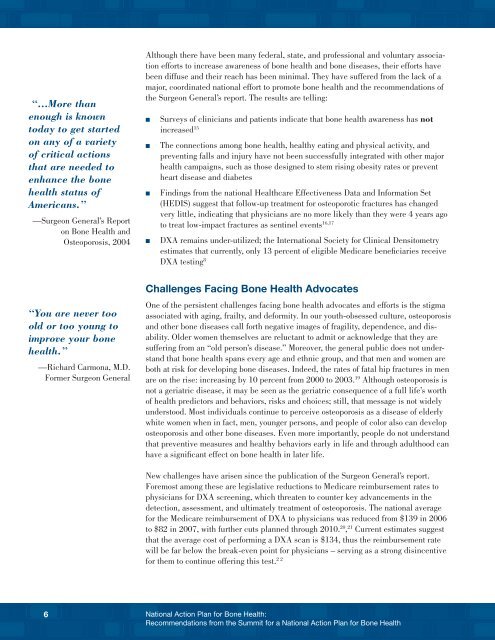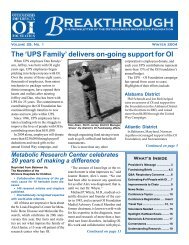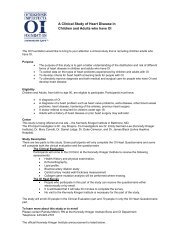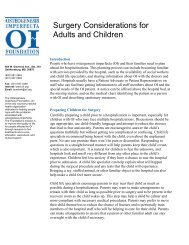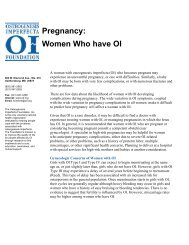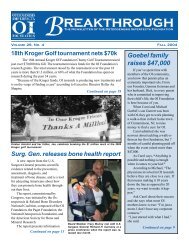National Action Plan for Bone Health - Osteogenesis Imperfecta ...
National Action Plan for Bone Health - Osteogenesis Imperfecta ...
National Action Plan for Bone Health - Osteogenesis Imperfecta ...
Create successful ePaper yourself
Turn your PDF publications into a flip-book with our unique Google optimized e-Paper software.
“…More than<br />
enough is known<br />
today to get started<br />
on any of a variety<br />
of critical actions<br />
that are needed to<br />
enhance the bone<br />
health status of<br />
Americans.”<br />
—Surgeon General’s Report<br />
on <strong>Bone</strong> <strong>Health</strong> and<br />
Osteoporosis, 2004<br />
Although there have been many federal, state, and professional and voluntary association<br />
ef<strong>for</strong>ts to increase awareness of bone health and bone diseases, their ef<strong>for</strong>ts have<br />
been diffuse and their reach has been minimal. They have suffered from the lack of a<br />
major, coordinated national ef<strong>for</strong>t to promote bone health and the recommendations of<br />
the Surgeon General’s report. The results are telling:<br />
n<br />
n<br />
n<br />
n<br />
Surveys of clinicians and patients indicate that bone health awareness has not<br />
increased 15<br />
The connections among bone health, healthy eating and physical activity, and<br />
preventing falls and injury have not been successfully integrated with other major<br />
health campaigns, such as those designed to stem rising obesity rates or prevent<br />
heart disease and diabetes<br />
Findings from the national <strong>Health</strong>care Effectiveness Data and In<strong>for</strong>mation Set<br />
(HEDIS) suggest that follow-up treatment <strong>for</strong> osteoporotic fractures has changed<br />
very little, indicating that physicians are no more likely than they were 4 years ago<br />
to treat low-impact fractures as sentinel events 16,17<br />
DXA remains under-utilized; the International Society <strong>for</strong> Clinical Densitometry<br />
estimates that currently, only 13 percent of eligible Medicare beneficiaries receive<br />
DXA testing 8<br />
“You are never too<br />
old or too young to<br />
improve your bone<br />
health.”<br />
—Richard Carmona, M.D.<br />
Former Surgeon General<br />
Challenges Facing <strong>Bone</strong> <strong>Health</strong> Advocates<br />
One of the persistent challenges facing bone health advocates and ef<strong>for</strong>ts is the stigma<br />
associated with aging, frailty, and de<strong>for</strong>mity. In our youth-obsessed culture, osteoporosis<br />
and other bone diseases call <strong>for</strong>th negative images of fragility, dependence, and disability.<br />
Older women themselves are reluctant to admit or acknowledge that they are<br />
suffering from an “old person’s disease.” Moreover, the general public does not understand<br />
that bone health spans every age and ethnic group, and that men and women are<br />
both at risk <strong>for</strong> developing bone diseases. Indeed, the rates of fatal hip fractures in men<br />
are on the rise: increasing by 10 percent from 2000 to 2003. 19 Although osteoporosis is<br />
not a geriatric disease, it may be seen as the geriatric consequence of a full life’s worth<br />
of health predictors and behaviors, risks and choices; still, that message is not widely<br />
understood. Most individuals continue to perceive osteoporosis as a disease of elderly<br />
white women when in fact, men, younger persons, and people of color also can develop<br />
osteoporosis and other bone diseases. Even more importantly, people do not understand<br />
that preventive measures and healthy behaviors early in life and through adulthood can<br />
have a significant effect on bone health in later life.<br />
New challenges have arisen since the publication of the Surgeon General’s report.<br />
Foremost among these are legislative reductions to Medicare reimbursement rates to<br />
physicians <strong>for</strong> DXA screening, which threaten to counter key advancements in the<br />
detection, assessment, and ultimately treatment of osteoporosis. The national average<br />
<strong>for</strong> the Medicare reimbursement of DXA to physicians was reduced from $139 in 2006<br />
to $82 in 2007, with further cuts planned through 2010. 20 , 21 Current estimates suggest<br />
that the average cost of per<strong>for</strong>ming a DXA scan is $134, thus the reimbursement rate<br />
will be far below the break-even point <strong>for</strong> physicians – serving as a strong disincentive<br />
<strong>for</strong> them to continue offering this test. 2 2<br />
6 <strong>National</strong> <strong>Action</strong> <strong>Plan</strong> <strong>for</strong> <strong>Bone</strong> <strong>Health</strong>:<br />
Recommendations from the Summit <strong>for</strong> a <strong>National</strong> <strong>Action</strong> <strong>Plan</strong> <strong>for</strong> <strong>Bone</strong> <strong>Health</strong>


